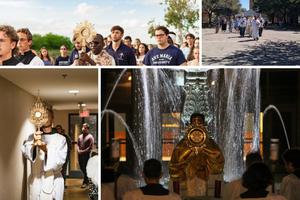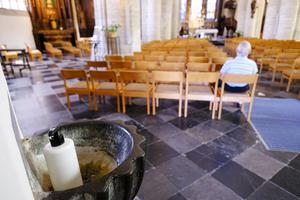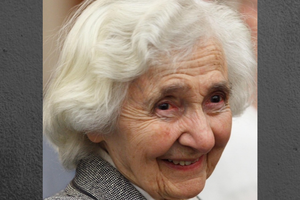What Does Eucharistic Revival Look Like?
COMMENTARY: We Catholics should recognize extraordinary developments like those currently at Asbury University as signs that God himself is already at work to bring about a Eucharistic revival greater than we could dream of.

What began as an ordinary chapel service at Asbury University in Wilmore, Kentucky, has turned into a “revival” that has made headlines in secular media around the world and brought visitors from as far as New Zealand, Indonesia, Finland and Brazil.
Students at that chapel service on Feb. 8, struck by a quiet but powerful sense of the presence of God, did not leave but stayed to worship. Others arrived, and the worship went on overnight, then continuously, with no signs of stopping yet (although the university has had to limit public attendance). Those who come describe an atmosphere of deep prayer, with testimonies, tears, conversions, confessions of sin, reading of Scripture and praise.
This past weekend, the little town of Wilmore saw an influx of more than 20,000 people hungry for a move of God. Meanwhile, the revival is spreading to other college campuses.
For Catholics, it can hardly escape notice that this revival has occurred as we are eight months into the “Eucharistic Revival” initiated by the U.S. bishops — a three-year movement to renew the Church by rekindling devotion to the Eucharist, the source and summit of our life.
I believe this concurrence of events is no mere coincidence, but is a prophetic sign. It is as if the Lord, hearing the prayers of so many Catholics desperate for a restoration of faith and life in the midst of a radically secularized age, is giving us a picture of what revival looks like.
It is significant that the U.S. bishops, led by Bishop Andrew Cozzens of Crookston, Minnesota, have chosen the term “revival” for the rekindling of Eucharistic faith that they hope will come about. The more familiar term “renewal” could suggest a human effort to improve something that is in poor condition, like an urban renewal project. Or “reform” would imply a change of practices or structures in hopes of improvement.
But “revival,” which literally means a bringing alive of what was dead, is something only God himself can do. Revival cannot be achieved by any human efforts, programs or strategies, no matter how sincere and energetic. After showing the prophet Ezekiel a valley full of dry bones, God explained that they were an image of Israel: spiritually lifeless, barren and hopeless. Then God commanded, “Prophesy, and say to them, ‘Thus says the Lord God: Behold, I will open your graves, and raise you from your graves, O my people’.” God alone can put flesh on dry bones and breathe into his people the breath of divine life.
Perhaps the best definition of “revival” in the sense used of Asbury today is from Bill Bright, the late founder of Campus Crusade for Christ:
“Revival is a divine visitation, a sovereign work of God — in answer to sincere, prevailing prayer. During a revival God will:
1. Grip His people with deep conviction, repentance, forgiveness, and deliverance from personal sins.
2. Fill His people with the Holy Spirit and manifest through them the fruit and graces of the Holy Spirit.
3. Fill the church and community with His presence and power.
4. Cause non-Christians to earnestly seek Him.
5. Ignite in His people, young and old, a passion to bring the lost to Christ at home and around the world.”
What would happen if the Catholic Church in the U.S. began experiencing a Eucharistic Revival in this sense? Many people who are now living a life of compromise, receiving the Eucharist while continuing in grave sin, or showcasing their Catholic faith while promoting radically secular values and policies, would be gripped with conviction and make a beeline to the confessional.
Many of those who go through the motions, attending Mass but spiritually stagnant, would surrender their lives entirely to Jesus as his disciples, be set on fire with the Holy Spirit and begin to manifest his charismatic and sanctifying gifts. People would begin to subjectively experience the living presence of Jesus in the tabernacle and especially in the Eucharistic liturgy of the gathered Church. Even nonbelievers would inexplicably become desperately thirsty for God and show up at the church door, begging for someone to lead them to living water.
Young Catholics in droves, and even older, previously pew-warming Catholics, would be stirred with zeal to bring the Gospel to the lost, whether to the neighbor next door or the tribesman in Fiji — a zeal like that of Sts. Patrick, Cyril and Methodius, Francis Xavier, Frances Cabrini and Thérèse of Lisieux.
The key words in Bright’s definition are “divine visitation” and “sovereign work of God.” Such a spiritual awakening — like that of the extraordinary revivals that took place in 13th-century Europe at the preaching of the early Franciscans — happens when and how God chooses. But we can hasten it by sincere, prevailing prayer. And when the Lord does begin such a visitation, it is also essential that we give him room to do what he will, as the Asbury University administration has done by welcoming throngs of visitors and allowing students to worship day and night and even to miss classes, within reasonable limits.
Imagine a time of Eucharistic adoration in which the Lord started to move so powerfully, touching hearts and changing lives, that people didn’t want to leave. Imagine the pastor or deacon being so willing to let the Holy Spirit act as he will that they changed plans and let the church stay open, welcoming outsiders and letting groups of people minister to each other through prayer, praise and testimony. Imagine unbelievers falling on their face and declaring, “God is really among you” (1 Corinthians 14:25). Witnessing this, who would then not believe in the Real Presence of Jesus in the Eucharist?
There is one other curious “coincidence” that should give hope that the Lord is up to something greater than we can now see. At the very time Catholics are in our “Eucharistic Revival,” a remarkable range of Protestant leaders have been testifying to their own kind of “communion revival” — a revival of devotion to and faith in the presence of Jesus in holy communion, his gift of himself in the Lord’s Supper.
Of course, they do not fully share the Catholic understanding of the sacrament, though many of them do have a very high view of the Eucharist. But apart from any human planning, God is drawing them closer to the Church’s ancient understanding.
Famed evangelical pastor Francis Chan said recently, “I didn’t know that for the first 1,500 years of church history, everyone saw [communion] as the literal Body and Blood of Christ, and it wasn’t until 500 years ago that someone popularized a thought that it’s just a symbol and nothing more. …. For 1,500 years there was never one guy and his pulpit being the center of the church; it was the Body and Blood of Christ. … I’ve been dreaming about this. I’ve been praying about this. … I would love it if one day in our country, here in the U.S., people understood the Body of Christ, that they were just a part of it, and they got excited to gather and partake of the Body and Blood of Christ.”
Protestant charismatic leader Lou Engle, known for his massive prayer rallies, has been calling for “The Great Communion Revival,” exalting the power of Christ’s blood received in communion together with other believers.
Charismatic Protestant pastor Bill Johnson of Bethel Church in Redding, California, speaks of how he has begun to receive communion daily at his church and that it is one of the most important parts of his life. “This is not symbolic; this is life.”
Pentecostal healing evangelist Benny Hinn publicly stated, “More people are healed in a Catholic church than Pentecostal churches. That’s an absolute fact … because Catholic people revere the Eucharist. More people get healed in a Catholic church during Communion than Pentecostals, because to us it’s [merely] symbolic. But Jesus didn’t say, ‘This is symbolic of my body’; he said, ‘This is my body’; he didn’t say, ‘This is symbolic of my blood’; he said, ‘This is my blood.’”
We Catholics should recognize these extraordinary developments as signs that God himself is already at work to bring about a Eucharistic revival greater than we could dream of — one that not only rekindles faith in the sacrament at the center of our lives, but that even begins to bring back together the broken Body of Christ, so that all Christ’s followers may once again sit down together at a single Eucharistic table.

















